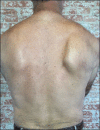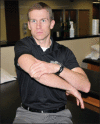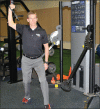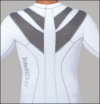The role of the scapula - PubMed (original) (raw)
The role of the scapula
Russ Paine et al. Int J Sports Phys Ther. 2013 Oct.
Abstract
Previously, the scapular musculature was often neglected in designing a rehabilitation protocol for the shoulder. In the past two decades a significant amount of research has been performed in order to help identify the role of the scapula in upper extremity function. Weakness of the scapular stabilizers and resultant altered biomechanics could result in: 1) abnormal stresses to the anterior capsular structures of the shoulder, 2) increased possibility of rotator cuff compression, and 3) decreased shoulder complex neuromuscular performance. This clinical commentary presents facts about the anatomy and biomechanics of the scapula and surrounding musculature, and describes the pathomechanics of scapular dysfunction. The focus is upon the assessment of dysfunction and retraining of the scapular musculature.
Level of evidence: 5.
Keywords: scapular biomechanics; scapular musculature; scapular strengthening; shoulder rehabilitation.
Figures
Figure 1.
(a) Wall push – press into wall using fingertips. Avoid leaning into wall with body. Observe backward winging of the scapula. (b) Lift 3–5# dumbbell and lower to position shown (45 degrees). Observe backward winging of scapula.
Figure 2.
Notice prominence of the medial border of the right scapula during only a fingertip press into wall.
Figure 3.
Genie Stretch – Begin stretch in “Genie Position” with involved arm below normal. Limit external rotation using top arm as the control arm. Lift the elbow slightly then pull across chest in a diagonal movement. Make sure that subject perceives stretch on top and or posterior aspect of shoulder. Coracoid impingement will occur if subject feels pinching in front. This can be avoided by lowering angle towards opposite hip.
Figure 4.
Dynamic Hug – using cable column, can also be performed using Theraband. Instruct the patient to reach forward as if “hugging a tree”. Target muscle, serratus anterior.
Figure 5.
Cheerleader Exercise – Using Theraband, perform alternating diagonal patterns with one bilateral horizontal abduction motion between each diagonal. Target muscles, lower trapezius, rhomboids.
Figure 6.
Swiss Ball “Robbery” – Prone on a Swiss Ball, assume “robbery” position, cuing patient to point elbows to back pockets. Target muscle, lower trapezius.
Figure 7.
Cocking Cable Column – Perform D2 diagonal pattern pulling into a cocked position, then slowly lower to decelerate. Target muscles, lower trap, rhomboid, posterior cuff.
Figure 8.
(a) Manual Resisted protraction/retraction – Manual resistance applied to anterior shoulder and spine of scapula while patient performs protraction, retraction. Target muscles, serratus anterior and rhomboids. (b) Bilateral PNF – Manual resisted D2 bilateral PNF pattern. Target muscles, lower trap, rhomboid, posterior cuff.
Figure 9.
(Super 6 Scapular Routine (a‐f) Series of reciprocal scapular exercises that target scapular, rotator cuff, and trunk musculature. a. Upright Row, b. Dynamic Hug, c. Cocking/Deceleration, d. Cocking/Acceleration, e. Bilateral D2, f. Bilateral Pullover
Figure 10.
Bear Crawl – Walk out on hands while in a plank position on swiss ball, then perform push‐up with a plus. Target muscles, serratus anterior, pectoralis major.
Figure 11.
Seated Pike Lift – Using large dumbbells or blocks, lift buttocks off table and hold for 20 seconds. Target muscle, lower trapezius.
Figure 12.
Standing “snow angels” – Stand with back against wall, keeping scapula, back of hands, and forearms touching wall. Move hands to overhead pressing motion then return with arms to side. Light cuff weights are used to provide additional resistance.
Figure 13.
Scapular shirt – Scapular shirt used to help maintain proper posture and scapular positioning.
Similar articles
- The role of the scapula.
Paine RM, Voight M. Paine RM, et al. J Orthop Sports Phys Ther. 1993 Jul;18(1):386-91. doi: 10.2519/jospt.1993.18.1.386. J Orthop Sports Phys Ther. 1993. PMID: 8348140 Review. - The role of the scapula in the rehabilitation of shoulder injuries.
Voight ML, Thomson BC. Voight ML, et al. J Athl Train. 2000 Jul;35(3):364-72. J Athl Train. 2000. PMID: 16558649 Free PMC article. - Shoulder muscle activity and function in common shoulder rehabilitation exercises.
Escamilla RF, Yamashiro K, Paulos L, Andrews JR. Escamilla RF, et al. Sports Med. 2009;39(8):663-85. doi: 10.2165/00007256-200939080-00004. Sports Med. 2009. PMID: 19769415 Review. - Infraspinatus strength assessment before and after scapular muscles rehabilitation in professional volleyball players with scapular dyskinesis.
Merolla G, De Santis E, Sperling JW, Campi F, Paladini P, Porcellini G. Merolla G, et al. J Shoulder Elbow Surg. 2010 Dec;19(8):1256-64. doi: 10.1016/j.jse.2010.01.022. Epub 2010 Apr 24. J Shoulder Elbow Surg. 2010. PMID: 20421171 - The scapula in rotator cuff disease.
Kibler WB. Kibler WB. Med Sport Sci. 2012;57:27-40. doi: 10.1159/000328877. Epub 2011 Oct 4. Med Sport Sci. 2012. PMID: 21986043 Review.
Cited by
- Evidence of rotator cuff disease after breast cancer treatment: scapular kinematics of post-mastectomy and post-reconstruction breast cancer survivors.
Lang AE, Milosavljevic S, Dickerson CR, Trask CM, Kim SY. Lang AE, et al. Ann Med. 2022 Dec;54(1):1058-1066. doi: 10.1080/07853890.2022.2065026. Ann Med. 2022. PMID: 35441571 Free PMC article. - Dynamic scapular recognition exercise improves scapular upward rotation and shoulder pain and disability in patients with adhesive capsulitis: a randomized controlled trial.
Mohamed AA, Jan YK, El Sayed WH, Wanis MEA, Yamany AA. Mohamed AA, et al. J Man Manip Ther. 2020 Jul;28(3):146-158. doi: 10.1080/10669817.2019.1622896. Epub 2019 Jun 14. J Man Manip Ther. 2020. PMID: 31200629 Free PMC article. Clinical Trial. - Effect of Repositioning Aids and Patient Weight on Biomechanical Stresses When Repositioning Patients in Bed.
Wiggermann N, Zhou J, McGann N. Wiggermann N, et al. Hum Factors. 2021 Jun;63(4):565-577. doi: 10.1177/0018720819895850. Epub 2020 Jan 30. Hum Factors. 2021. PMID: 31999485 Free PMC article. - A comprehensive review of scapulothoracic abnormal motion (STAM): evaluation, classification, and treatment strategies.
Gedik CC, Eren İ, Demirhan M, Elhassan B. Gedik CC, et al. Acta Orthop Traumatol Turc. 2024 Sep 18;58(4):187-195. doi: 10.5152/j.aott.2024.24066. Acta Orthop Traumatol Turc. 2024. PMID: 39319823 Free PMC article. Review.
References
- Paine RM, Voight ML. The role of the scapula. J Orthop Sports Phys Ther. 1993;18:386–391 - PubMed
- Peat M. Functional anatomy of the shoulder complex. Phys Ther. 1986;66:1855–1865 - PubMed
- Bigliani LU, Codd TP, Connor PM, Levine WN. Shoulder motion and laxity in the professional baseball player. Am J Sports Med. 1997;25:609–613 - PubMed
- Kamkar A, Irrgang JJ, Whitney SL. Nonoperative management of secondary shoulder impingement syndrome. J Orthop Sports Phys Ther. 1993;17:212–224 - PubMed
LinkOut - more resources
Full Text Sources
Research Materials
Miscellaneous












